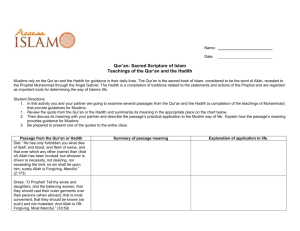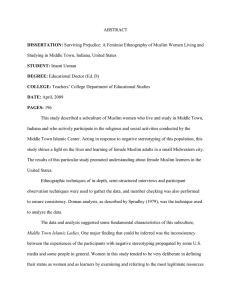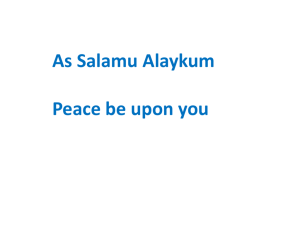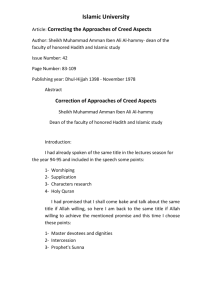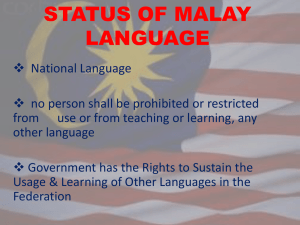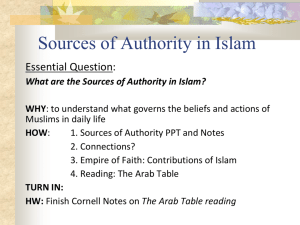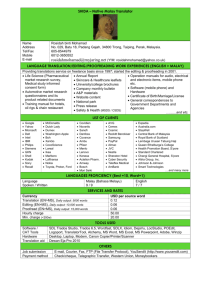Textual Exegesis of Malay Translations of Arabic
advertisement
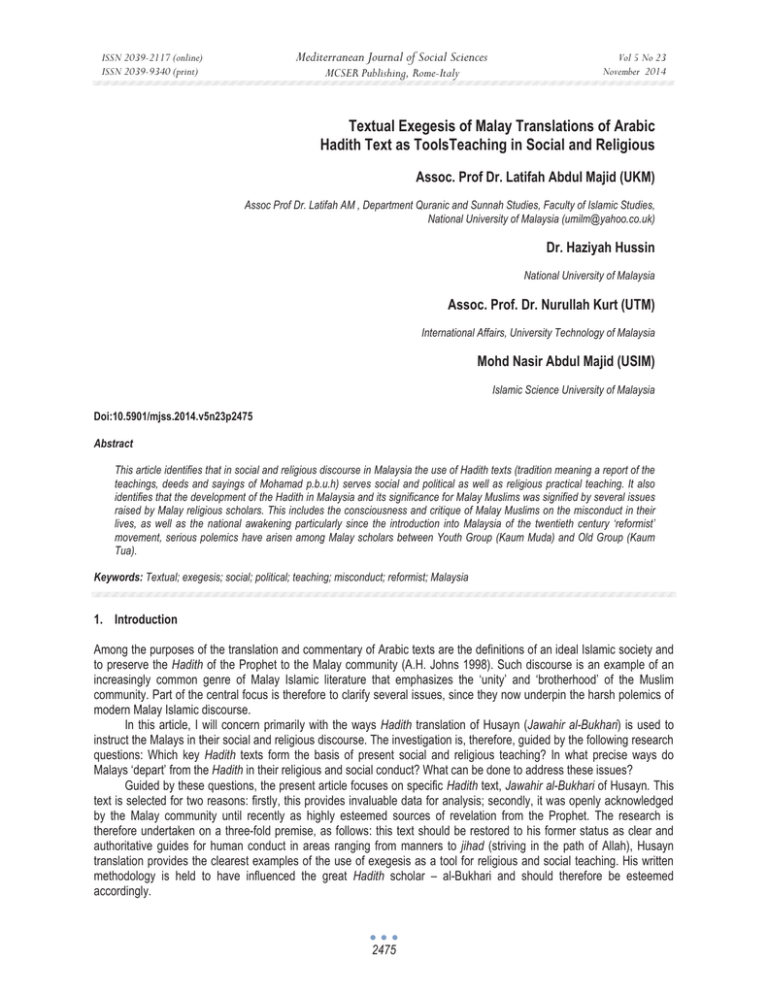
Mediterranean Journal of Social Sciences ISSN 2039-2117 (online) ISSN 2039-9340 (print) MCSER Publishing, Rome-Italy Vol 5 No 23 November 2014 Textual Exegesis of Malay Translations of Arabic Hadith Text as ToolsTeaching in Social and Religious Assoc. Prof Dr. Latifah Abdul Majid (UKM) Assoc Prof Dr. Latifah AM , Department Quranic and Sunnah Studies, Faculty of Islamic Studies, National University of Malaysia (umilm@yahoo.co.uk) Dr. Haziyah Hussin National University of Malaysia Assoc. Prof. Dr. Nurullah Kurt (UTM) International Affairs, University Technology of Malaysia Mohd Nasir Abdul Majid (USIM) Islamic Science University of Malaysia Doi:10.5901/mjss.2014.v5n23p2475 Abstract This article identifies that in social and religious discourse in Malaysia the use of Hadith texts (tradition meaning a report of the teachings, deeds and sayings of Mohamad p.b.u.h) serves social and political as well as religious practical teaching. It also identifies that the development of the Hadith in Malaysia and its significance for Malay Muslims was signified by several issues raised by Malay religious scholars. This includes the consciousness and critique of Malay Muslims on the misconduct in their lives, as well as the national awakening particularly since the introduction into Malaysia of the twentieth century ‘reformist’ movement, serious polemics have arisen among Malay scholars between Youth Group (Kaum Muda) and Old Group (Kaum Tua). Keywords: Textual; exegesis; social; political; teaching; misconduct; reformist; Malaysia 1. Introduction Among the purposes of the translation and commentary of Arabic texts are the definitions of an ideal Islamic society and to preserve the Hadith of the Prophet to the Malay community (A.H. Johns 1998). Such discourse is an example of an increasingly common genre of Malay Islamic literature that emphasizes the ‘unity’ and ‘brotherhood’ of the Muslim community. Part of the central focus is therefore to clarify several issues, since they now underpin the harsh polemics of modern Malay Islamic discourse. In this article, I will concern primarily with the ways Hadith translation of Husayn (Jawahir al-Bukhari) is used to instruct the Malays in their social and religious discourse. The investigation is, therefore, guided by the following research questions: Which key Hadith texts form the basis of present social and religious teaching? In what precise ways do Malays ‘depart’ from the Hadith in their religious and social conduct? What can be done to address these issues? Guided by these questions, the present article focuses on specific Hadith text, Jawahir al-Bukhari of Husayn. This text is selected for two reasons: firstly, this provides invaluable data for analysis; secondly, it was openly acknowledged by the Malay community until recently as highly esteemed sources of revelation from the Prophet. The research is therefore undertaken on a three-fold premise, as follows: this text should be restored to his former status as clear and authoritative guides for human conduct in areas ranging from manners to jihad (striving in the path of Allah), Husayn translation provides the clearest examples of the use of exegesis as a tool for religious and social teaching. His written methodology is held to have influenced the great Hadith scholar – al-Bukhari and should therefore be esteemed accordingly. 2475 ISSN 2039-2117 (online) ISSN 2039-9340 (print) Mediterranean Journal of Social Sciences MCSER Publishing, Rome-Italy Vol 5 No 23 November 2014 2. Methodological Perspectives The diversity of the problems raised in this study calls for the employment of different research methodological devices for their solution. Research methodology is a framework that guides the researcher in conducting the research appropriately. Basically, it is required to analyze a set of data before any evaluation, justification or examination can be made on the related issues. Therefore, in the interests of validity and reliability, the study provides multiple sources of evidence. These include tape-recorded in-depth interviews with researchers (in particular with an expert educationalist in twentieth century social, political and religious affairs in Malaysia) and academicians who are biographers of the two great scholars identified. Groups of Malaysian people were selected as respondents in this study who are academicians and scholars, and who are profoundly involved in Malay manuscripts (for instance Wan Saghir Wan Abullah), biographers, and also specific peoples who are closely related to and/or heirs of this scholar. Interviews involve a set of assumptions and understandings about the situation which are not normally associated with a casual conversation. The present study believes that interviews can be a very effective method in this research. It is because an interview is a conversation with a purpose. Thus, this method is a useful technique, as Robson (1999:229) suggests that “interview procedure can be an obvious short cut in seeking answers to research question. He noted further that nonverbal sign may give messages which help in understanding the verbal response”. Regarding the interview conference, this research applied in-person or face to face interviews (Creswell 1951:151). This is because “face to face interviews offer the possibility of modifying one’s line of inquiry, following up interesting responses and investigating underlying motives in a way that postal and other self administered questionnaires cannot”(Robson 1999:229-231). This study applied a semi-structured interview (Denscombe), “where the interviewer has planned out a set of questions in advance, but freed herself to modify their order based upon her perception of what seems most appropriate in the context of the conversation”. As for the purpose of the meeting, the researcher then prepared a great task which required advance preparation and planning. The interviews required careful preparation, such as an arrangement to visit, securing necessary permissions, confirming arrangements, and rescheduling appointments (in terms of covering any absences). Audio taperecording also has been used during the interview session. It offers a permanent record and security, that is, fully completed evidence in terms of the speech data (Descombe 1998:122). Under certain circumstances, especially when interviewees declined to be tape-recorded, the researcher utilized the written field note technique. In some fields however, it appeared increasingly difficult to obtain highly successful co-operation from potential interviewees. Therefore, due to these reasons and unexpected obstacles, the researcher also considered an interview via e-mail and phone calls. Thus, this method is used for the analysis of Hadith texts in the Malay world and for the reconstruction of Husayn’s biography and his intellectual activities. In order to accomplish all the information and data gathering for the present article, library research method was also adopted. The library is the source of a wide range of related written documents such as books, journal, magazines, and newspapers, gathered via website and internet research. I extracted the data from written materials such as manuscripts, articles, books, journals, and newspapers from all of the related institutions. In accordance with the objectives of the article several Hadith books which were believed to be evidence of the contribution of prominent Malay scholars in this period has been selected. The Hadith books that were purposely chosen for this matter is Jawahir alBukhari of Husayn. My approach to the text builds also on the employments of the interpretation approach used in the understanding of text. I will be concerned not so much with the philological questions arising in recasting Arabic into Malay, as with the social and religious contexts in which translation is located, the internal logic of the Malaysian text and the ways it is understood by contemporary readers of diverse theological orientations. It is believed that understanding the internal logic of the text requires exploring its claims on the larger semantic fields in which it is located. These include the Sunni Muslim discourse concerning society, ethics, and ritual, the religious practice, social and political thought (Woodward 1993). It also concerned that the Hadith translations speak the past by describing the words and deeds of the Prophet Muhammad. They speak the present by placing Hadith in the context of Malay social and religious discourse. They speak the future by defining a vision of an ideal Islamic society rooted in the prophetic ideal. In Malay texts, what is not said, or what is said only by implication, is often at least as important as what is said directly. There are linguistic and political reasons for the prevalence of indirect speech in public discourse. Direct speech is considered to be rude and insulting. It can also be dangerous. In a political context, where direct criticism of authority is limited, Muslim preachers and authors often invoke the prophetic ideal to critique current social political conditions.This article therefore, is based on historical methods. It is important to note that research methods used to examine the original writings of Husayn are largely 2476 ISSN 2039-2117 (online) ISSN 2039-9340 (print) Mediterranean Journal of Social Sciences MCSER Publishing, Rome-Italy Vol 5 No 23 November 2014 ‘qualitative’, and consist of approaches such as ‘hermeneutics and the ‘inferential’ technique of content analysis. 3. Objectives of the Article In the light of Husayn strong influence upon such esteemed Hadith scholars as al-Bukhari and al-Qastalani, it is argued that the writings of Husayn represent a vital resource for the purposes of educating the Malay people on the subject of the Hadith. The article’s conclusions are therefore two-fold: firstly, the writing of Husayn is crucial to the purity of fundamental Islamic principles, and therefore have a vital role to play as transmitters of authoritative Hadith teachings to the Malay community. Secondly, if social and religious discourse is based on the purity of this translation, then all such discourse will be legitimized as deriving directly from the sayings of the Prophet. All in all, the main objective of this article is to present a role of Jawahir al-Bukhari, based on all available text of the work and provided with an explanation the methods of writing has been applied in order to facilitate a better understanding of the Hadith to Malay readers .The achievement of the objective thus formulated also demands a determination of the date and sources of the work, the purpose of its composition and its significance within the domain of the lives of Malay Muslims. Thus, the aim of this article is to determine the significance of Hadith text for Malay Muslims as tools for religious and social teaching. 4. The Scope of Study This article is concerned primarily with the use of specific Hadith text (Jawahir al-Bukhari ) as a tool for religious and social teaching in Malaysia. It is an attempt to provide a part work on the subject, particularly the role of this text in terms of his transmission of fundamental Islamic principles to Malay Muslims. The present article relates only to specific aspects of religious and ethical teaching, such as the obligation of prayer to Muslims and the importance of congregational prayer as basic elements in the lives of Malay Muslims. Thus, the obligation of fasting during Ramadhan, for instance, will not be part of the focus of the study. In this article I also concerned to present Jawahir al-Bukhari teachings that guide believers in right conduct in their social interactions , beginning with that on ‘proper manners’, the importance of Malay unity, a critique of Malay Muslim beliefs and practices which are clearly prohibited by the Prophet’s words and example. Importantly, it is worth to note here that this text urge the pursuit of knowledge only in the name of Allah (S.W.T) and at the same time using exegesis as a tool for a critical interpretation of the Holy Qur’an and the Hadith without prior learning, as in the example of the Kaum Muda (Roff 196:60) movement. However, since the present article has no further attempt to rephrase history and not a comprehensive study, therefore there is no further intent in the present discussion to give detailed descriptions on such topics. 5. The Date of the Jawahir Al-Bukhari Unfortunately, concerning Jawahir al-Bukhari ‘s work, Husayn does not provide the exact date when he finished writing. According to Saghir, the earliest dated manuscript known to have survived was published by the Maktabah al-Zayniyah Press, Taiping, Perak in 1931. On the front page of the text (1st volume), it informs us that it was published in 1931, by consent of the Sultan of Perak. This earliest publishing of the text thus indicates that the work must have been written in or earlier than 1930. There is a strong possibility, however, that the Jawahir al-Bukhari was written between 1925 and 1930. This is based on invaluable information given in the collections of Mustafa cImarah (the work on al-Qastalani’s commentary) as Husayn stated in his text: “the commentary of al-Qastalani was commented on by Mustafa as well”. The collections of Mustafa were examined by the scholars of University al-Azhar in 1922, and it therefore seems highly plausible that Husayn’s text may has been written sometime between 1925 and 1930, after the collections of Mustafa, to offer the Malay community an interpretation of Hadith teaching and thus save them from false imitations of these truths, although it is very interesting to note here that nowhere in his work does he mention the date. 6. The Significance of Jawahir Al-Bukhari for Malay Readers Having noticed the great need of those Muslims in Malaysia (Ahmad 1977) to learn the correct authentic Hadith of the Prophet, and also to acknowledge Sahih Hadith (of al-Bukhari ) as the most authentic of the Prophet’s Hadith, therefore Husayn undertook the project of translating (al-Qastalani’) the meanings of the Hadith and its contents into the Malay 2477 ISSN 2039-2117 (online) ISSN 2039-9340 (print) Mediterranean Journal of Social Sciences MCSER Publishing, Rome-Italy Vol 5 No 23 November 2014 language to serve the Muslim community, as illustrated in his introduction. Thus, the scholar asserts that: “I have translated this book because of the encouragement I have received from the scholars and my friends to translate the Jawahir al-Bukhari wa bacdu sharh of al-Qastalani ”(Husayn 1931:2) Husayn tells his readers the rationale for writing the work, relating that some of his friends requested him to compose this text. His readers are not specifically informed who his friends are, the reason for their request or what sort of questions or problems led to the request. Nevertheless, he informs these friends that he wrote the work in order to enlighten them in their understanding of the Hadith literature of Bukhari, because being Malay; they did not comprehend these texts in Arabic (Husayn: 1-3). Husayn then proceeds to enlighten his readers about the importance for the Malay community of learning Hadith. According to him: The study of the Hadith, which is received from the best of mankind, is the noblest thing which has been singled out for special attention, and the most appropriate thing in which precious days should be spent. No rational man would doubt that the axis of these sciences is the Book of Allah (which is) followed and the Sunna of His select Prophet. The remaining sciences are either tools to understand them, and they are the lost things which are sought, or they are unrelated to them, and they are the harm to be overcome. Thus, the author sees it as his task to throw light upon the relevance of the Hadith to the religious and social life of Muslims in Malaysia. Husayn reminds his readers that the sayings and actions of the Prophet not only complement the Qur’an, but, being the authentic record of the Prophet’s life, they also lead followers to the source of revelation and provide them with access to the inner, spiritual dimension of the Hadith teachings. Husayn mentions that every religion seeks to build ideal patterns of society, prescribing certain ethical rules and devotional observances for achieving that end. Life in harmony with the spirit of such rules and laws can be realized only by forming and moulding the life of the followers of that religion after the perfect model of that system. Thus, in the case of Islam, this model is obviously the life of the Prophet because his Hadith provide us with the means of realizing the inner reality, the gist and spirit of the Islamic system of beliefs and observances. It may not be clear at whom Husayn actually primarily aimed his work. Was it to a particular group he calls ‘kepada kekasihku, (my beloved friends), or to the public in general whom he addressed as ‘encik-encik or tuan-tuan’ (ladies and gentlemen) who were unable to understand Arabic. However, having examined his work, we may state firmly that the author did not have any particular group directly in mind while writing this work. It appears from the evidence discussed that the text was written as a guide to the Hadith text for the public (which means for all people and Malay Muslims) on matters concerning Islamic teaching. In addition, Saghir and Hafiz assert that because of the movement which seeks to renew and strengthen the role of Islam in the faith and deeds of the Malay Muslims, calls for greater knowledge of the Hadith continue to be stressed by the scholars in this century (Saghir 2005). Furthermore, we will see many cases where texts of the Hadith were prepared with this effort in mind as Federspiel (1970:4) writes: The ‘revivalist and propagation movement’ aside, many lay Muslims undertake their own informal studies of religion as a pious activity. They seek privately - alone, in family sessions or through meetings among friends - to learn more about their own religion and its various aspects to improve their own understanding of the beliefs and practices of Islam and thereby allow them to improve their own behaviour. Studying and reading Traditions (Hadith) has been an important part of such religious intensification’. Federspiel (1970) and (A.H. Johns 1984) concluded that “literature concerning the Hadith (whether it is explanatory or inspirational in nature) plays its role here, both for the scholars and for those who are the object of this renewal”. Thus, whether he wrote the commentary to comply with his friends’ or the people’s request, what is clear is that Husayn took the responsibility very seriously to disseminate the Hadith to Malay readers. Thus, we understand that the work was composed by Husayn in this century to impart to non Arabic speakers a true understanding of the Hadith teachings in their language and more importantly as a teaching for the Malay society (Azra 2006 ;A.H. Johns 1984) (K.S. Nathan and Mohammad Hashim Kamali). It can be seen, then, from the content of the text that the clarity with Husayn has dealt with all areas of human conduct makes his teachings a vital tool for religious and social discourse in contemporary Malaysia (Wan Sabri et al 2004). According to Fauzi (1999) and Ngah (1983), this is particularly the case since among the purposes of the translations and commentaries of Arabic texts was the definition of an ideal Islamic society and, importantly, indications of the ways in which Malays fall short of this ideal. In line with this argument, Bernard Lewis (1988), for example, has stated that the contemporary translations are examples of what he terms an ‘authoritarian and quietist’ mode of Malay Muslim practical thought. Therefore, it is stated by Faisal (2008) that in the context of Malaysian political culture these authors 2478 ISSN 2039-2117 (online) ISSN 2039-9340 (print) Mediterranean Journal of Social Sciences MCSER Publishing, Rome-Italy Vol 5 No 23 November 2014 adopt this method to seek to restructure the Malay Muslim society into the ideal Islamic society based on the Hadith of the Prophet. Hence, in the Jawahir al-Bukhari ‘s text, the ‘introduction’ is replaced by a brief statement explaining the significance of these texts for Malay readers. Husayn, for example, first stated his great respect for al-Bukhari’s work; portraying him as a great Hadith scholar who was blessed by Allah (S.W.T) with skill in Hadith scholarship. Husayn (1931:6)also mentioned his admiration for al-Bukhari because of his greatness in Hadith studies. It is stated that by an early age, al-Bukhari had memorised thousands of Hadith by heart with their complete chain of narrations( Abu Zahw 1958; Knoun 1969; Sheref 1982)) going from him to his teacher, and his teacher’s teacher (cAzami 1977; Fadel 1995), all the way to Muhammad, and by his sixteenth year, he became a ‘Master of Hadith” (Azizullah 1973; al-Khatib 1971). Woodward (1993) believes that “the appearance of extraordinary abilities at an early age is a common theme in Malay biographical myth and is often attributed to divine intervention”, politicians, leaders, and religious scholars for example are often said to have shown signs of greatness and divine inspiration as children. In addition, Woodward has pointed out that “the ability to memorize the Qur’an and Hadith without years of effort is thus held to be a gift from Allah and a sign of sainthood”. Therefore, for Malay readers, these personal qualities establish the sacred character of alBukhari’s work and link them with local concepts of sainthood. Woodward believes that the Malay text therefore “combines these approaches by establishing analogies between events in the early history of Islam and contemporary life and emphasizing the meanings of the text”. Similarly, here Husayn states that the types and qualities of blessing available to the early Muslim community can still be obtained. It is clear that Husayn decidedly seek to present the prominent Hadith scholars al-Bukhari, to the readers of his translation through the preservation of al-Bukhari’s Hadith. The Malay Muslim community and students of Hadith in Malaysia are able to continue to gain knowledge of their Hadith of al-Bukhari without doubt. That the book would be studied with and by actual or prospective scholars seem taken for granted; that the prominent scholar is once again part of this study circle is what bears emphasis here. Even more important, thanks to this new form of making the prominent scholar once again present, they can, in principle, be part of as many simultaneous study circles as there are printed texts enshrining their words. 7. The Teaching of the Importance of Prayers (Salat) As religious scholars of the Malay community, Husayn took a firm position on urging Malay Muslims not to miss any of the daily ritual prayers. They were adamant about following the Sunnah as strictly as possible, and therefore not being negligent about prayers. 8. The Pillars Of The Religion To begin a discussion of the significance of prayers to Muslims, Husayn for example points to a Prophetic Hadith that refers to Allah (S.W.T) terming prayers the ‘pillars of the religion’. In this, he was concerned that the behavior of Malay Muslims should reflect complete adherence to the example of the Prophet and the companions of the Prophet as he writes: ‘Allah (S.W.T) has prescribed the obligatory prayers and the Prophet’s Hadith declares that the prayers are the pillars of our religion’. Husayn’s interpretation of prayer as the pillars of religion is the clear significance of the Hadith which he states: The Prophet declares that Islam is based on (the following) five (principles): 1. To testify that none has the right to be worshipped but Allah, and that Muhammad is Allah’s Prophet. 2. To offer (compulsory congregational) prayers dutifully and perfectly. 3. To pay zakat (alms) 4. To perform Hajj 5. To observe fast during the month of Ramadhan. The above Hadith which was translated by Husayn reminds Malay Muslims of the need for devotional prayer because it is the pillar of Islam that the Prophet affirms after declaring the testimony of faith, by which one becomes a Muslim. In addition, Husayn asserts that to offer worship to Allah (S.W.T) was made obligatory upon all the prophets and for all Muslims (for example when Allah [S.W.T] spoke directly to Moses): And I have chosen you, so listen to that which is inspired for you. Verily, I am Allah! There is none worthy of worship but I, so worship Me and offer prayer perfectly for My remembrance (Al-Qur’an 20: 13-14) 2479 ISSN 2039-2117 (online) ISSN 2039-9340 (print) Mediterranean Journal of Social Sciences MCSER Publishing, Rome-Italy Vol 5 No 23 November 2014 For Husayn prayers are therefore an important dimension for a spiritual believer who wishes ‘to see’ and experience God’s ‘presence’. It is for this reason that the Jawahir al-Bukhari of Husayn (for example in ‘the topic of prayer’) contains comprehensive information on a wide variety of topics relating to prayer, including: the method by which Muslims clean themselves prior to the prayer; the different types of prayer; the actions that invalidate prayer; the necessary parts to prayer, and more. 9. The Dividing Line between Muslims and Non-Muslims As a wise, scholarly instructor, Husayn stresses the belief that prayer is the most important pillar of Islam, which is clearly demonstrated as the dividing line between belief and disbelief, which is for this reason discussed in detail as he states: Buraydah narrated that the Prophet declares: the covenant that is between us and them (unbelievers) is on the basis of prayer, so he who abandons it (in fact shows) infidelity (to Allah).(al-Bukhari, Sahih:1999) The translation then illustrates that prayer is compulsory for every Muslim who has reached puberty and is of sound mind. For Husayn, prayer is considered the principal mode of worship: so important that to miss one intentionally is a sin in Islam. Therefore he writes that the Prophet for this reason constantly reminded believers of its importance: cAbd Allah ibn Mascud narrated: “I asked the Prophet: ‘Which of these actions is the best?’ He replied ‘prayer at its stated time’. I said: ‘What comes next?’ He replied: ‘Kindness to parents’.(al-Bukhari, Sahih:1999) In this way, Husayn also teaches that prayer is not only a form of worship in Islam, but also a reminder that, by it, followers will be strengthened to abstain from ‘bad deeds’ (as they are more aware of their actions) and be protected from evil. Hence, with the help of the translation of Husayn, Malay Muslims can see that prayer is the best way to develop a sound personality and to ensure that every believer’s aspirations are set on a mature path to development, as the Prophet declares: When anyone of you observes rukuc (bowing down) and he recites thrice in his rukuc: ‘Glory be to my Lord, the Great’, he completes the rukuc; and that is the least of it. And when he sujud (prostrates) and says in his prostration three times: ‘Glory be to my Lord, the Highest’, his prostration becomes complete: and that is the least of it.(al-Bukhari, Sahih:1999) From this perspective, it is a lesson in discipline and determination, and a way to practice devotion to Allah (S.W.T).It is thus evident from the diversity of prayer topics discussed by al- Marbawi that his aim was to give advice and guidance to Malay Muslims following the path of Islam, and also to provide general guidelines on matters concerning prayer. 10. The Teaching of Adab in Muslim Life Husayn concurs in placing great stress on proper manners (adab) in Muslim life; his main concern here is that a true Muslim should maintain both an internal spiritual and external worldly discipline. Thus, as “the two worlds are closely related, it is important (for Muslims) to perfect their spirituality, and for their physical customs to reflect their inner spirituality” (Qamar ul-Huda 1991). For this reason, therefore, the concept of ‘adab’ is emphasized by Husayn in a symbolic sense, since these are inner concepts which should govern social structure and human interactions within it. Husayn’s emphasis upon adab (F.Gabrieli) stems from the conviction that it is necessary “to submit oneself wholly to the Sharica, which is the manifestation of divine order”. His purpose is thus to show Malay Muslim readers how to create through right behavior a perfect harmonious society, using an intensely structured model. ‘Adab is therefore a significant element in the text, because it demonstrates how all the minute details of individual conduct can be improved to reflect the wisdom of the Prophet Sunnah. According to Husayn, the believer needs to be prepared to fulfill this profound responsibility by controlling thoughts and actions at every moment, in every place. On this subject, he wrote: The Prophet declares that: Allah (S.W.T) had taught me good manners, and then He taught me wisdom in morality, to follow a virtuous path and give wise and virtuous advice. (al-Bukhari, Sahih:1999) Based on this reason, Husayn places prominent stress on adab. The Prophet’s words confirm that spirituality and inner wisdom manifests themselves in good manners; the result is social harmony, arising out of spiritual principles. Husayn therefore explains that the spiritual principle of good character in one’s dealings with others is above all to avoid harming, annoying or inconveniencing them, as declared by the Prophet: The [true] Muslim is one from whose tongue and hand other Muslims are safe.(al-Bukhari, Sahih:1999). 2480 ISSN 2039-2117 (online) ISSN 2039-9340 (print) Mediterranean Journal of Social Sciences MCSER Publishing, Rome-Italy Vol 5 No 23 November 2014 As a Muslim, we need to be guided by the words and example of the Prophet himself, as one with whom Allah Himself (S.W.T) was well pleased (as being, “of tremendous character”) and whose example was praised as “the most beautiful of examples” (Iqbal 1980:5) in the Qur’an. As Iqbal states, “we see that the basis of adab is to promote the social good, and spread love and mercy between humanity”. This text, hence, clearly emphasized that remembering and applying (both spiritually and socially) the Prophet’s Hadith on ‘adab’ is a crucial component in terms of strengthening the true meaning of the Prophet’s words for the minds, souls and actions of Muslims. At the same time, by using the Hadith in this way recreates the very same practices and movements which the Prophet performed in this world, and in a spiritual sense brings the believer closer to him. Husayn, on the other hand, refrains from comment here, but it can be inferred that practicing the Sunna of the Prophet is not merely imitation. Remembering all Hadith regarding ‘adab’ by heart would strengthen the piety of the Malay Muslim - that is, by performing the same physical movements and following the spirituality of the Prophet words and examples during his life. Husayn then reminds the Malay Muslim that the Prophet’s purpose in these ‘adab’ Hadith is not only to strengthen the piety and spirituality of the individual but beyond that there should be perfect bonding in unity to each and every Muslim community, as he cited: The Prophet claims: None of you would be a believer till I am dearer to him than his father, his children and (in fact) the whole of mankind. (al-Bukhari, Sahih:1999).. The Prophet, to Husayn, was ‘trained’ as the final messenger by Allah (S.W.T) and his words and examples as ‘final messenger’ are therefore handed down for all Muslim believers to follow (through the Qur’an and Hadith). As evidence throughout the discussion above, the writer (as evidenced throughout Jawahir al-Bukhari) clearly uphold the conviction that it is obligatory for every Malay Muslim to take the ‘adab’ Hadith into his or her heart in order to get closer to Allah (S.W.T) and His Prophet. 11. Adab as Tools Message for Muslim Unity in the Nation It is based on this strong foundation that Husayn creates for Malay Muslims the ideal of a perfect Muslim society in which adab operates within it throughout its spiritual symbolic sense, as well as socially, embracing kinship, authority, and obligations towards neighbours, the poor and orphans. From this perspective, Husyan uses the concept of kinship in a symbolic sense to show to the Malay Muslim how social structure and human relations is the fundamental layer in the type of community which the Prophet desires the believers of Allah to create. According to Husayn, adab is an essential part within the society, hence, Malay Muslims should maintain good relations with their relatives, and should not unjustly favour them over others. Moreover, a Muslim is required to be a good person to his or her neighbours regardless of their religion or belief (be it Buddhism, Hinduism, et cetera). Indeed, Malay Muslims ought to keep this in their hearts, as Husayn states: The Jibril kept recommending treating neighbours with kindness until I (the Prophet) thought he would assign a share of inheritance” (al-Bukhari, Sahih:1999).. This teaching (from the Hadith and discussion of it throughout Jawahir al-Bukhari highlights the profound importance in Islam of how we should behave towards our neighbours, and of the significance of our actions and words. The essential point here is that if we follow the Prophet way, then this relationship is a force for good, a purveyor of peace and justice for everyone, providing stability in a warring world without peace and harmony. Husayn, thus, clearly teaches us that precise ‘adab’ had to be followed at all times in order to follow and internalise the spirituality of the Prophet. In this way, through adherence to the Prophet’s Hadith, Husayn attempted to move his Malay Muslim readers from remembering the Prophet as a historical figure and to embodying his spirituality and his legacy in a living sense. For this reason also, he emphasised that the Prophet used to make ‘allegiance’ with whoever came to him that the convert would submit to Islam in faithfulness and spread good faith and counsel to other Muslims. To summarize, then, Husayn, as religious scholar, urge spiritual development through good moral conduct in all areas of human activity. His text (as a significant part of this development) suggests that each individual should know his own ability and weaknesses, and behave responsibly to correct and nurture his or her spirituality. Such self-discipline and effort are crucially important to prevent evil deeds and negative acts, towards themselves as well as towards other people. He emphasize that the acquisition of such high quality of moral conduct is essential to spiritualize the Malay 2481 ISSN 2039-2117 (online) ISSN 2039-9340 (print) Mediterranean Journal of Social Sciences MCSER Publishing, Rome-Italy Vol 5 No 23 November 2014 Muslim way of thinking. It was through this more ‘spiritual’ way of thinking that disputes and conflicts could be resolved by referring to the Prophet’s words and deeds. This spiritual development, in line with the Prophet’s example, will in turn enrich their communities and therefore develop their society. 12. The Critique of Malay Muslim Practice As spiritual scholar and teacher, Husayn was greatly concerned by the numerous superstitions (bidcah) among the Malays. The numerous superstitions continued to persist even with the coming of Islam, often becoming mixed with (and distorting) the great principles in Islam (Ishak 1993). These superstitions, as El Edrus observes, spanned a long cultural and religious history where ancient beliefs such as animism, dynamism, Hinduism, Buddhism et cetera, all featured in together (El-Edrus 1995). Husayn, thus, begins his response regarding this matter by instructing Malay believers in the first five fundamental basic principles of Islam as contained in the Hadith. His special attention is to show how the words of the Prophet demonstrate the reality of their meaning. This great scholar particularly stresses the importance of testifying to the great truth that there is no God but Allah (S.W.T.) and why we therefore worship Him as devout Muslims. To illustrate clearly, he gives an example of Hadith narrated by Ibn cUmar, where the Prophet declares that: Islam is based on the following five principles: to testify that none has the right to be worshipped but Allah (S.W.T), and that Muhammad is Allah (S.W.T)’s Messenger; to offer up congregational prayers as commanded dutifully and perfectly; to pay zakat (obligatory charity); to perform Hajj (pilgrimage to Mecca) and to observe the commandment to fast during the month of Ramadhan. (al-Bukhari, Sahih:1999) These fundamental principles are thus combined to teach that there is no God but Allah (S.W.T.) and that as followers of Islam they should give their faith to, worship and pray to Him only, and via no other belief or superstition. It is forbidden (and heretical) that they should seek the help in prayer of ancient spirits, for example, when it is the Most High who is our Creator (S.W.T) and who has given His Word to his Prophet that he might teach through his example. 13. Conclusion The text of Husayn illustrates what is a perfect Muslim society, in which he analyse ‘adab’ which includes kinship, authority, and obligations towards neighbours, the poor and orphans. From this perspective, Husayn uses the concept of relationship in a symbolic sense to discuss social structure and human relations in the life of the Malay Muslim. Therefore, the translation of Jawahir al-Bukhari take into accounts the significant of unity, neighbours, brotherhood and seeking knowledge; since they paint a picture of an ideal Muslim society. The text describe that in order to be an ideal society, therefore, Malay Muslims have to avoid among themselves disputed topics which do not bring any good to the community. Moreover, the scholars of Islam must not interpret any verses of the Qur’an or Hadith according to their own opinions and preferences. They must follow the consensus of Islamic scholars upon any issue, and they should not spread hate amongst Muslims, particularly those who disagree with them. In this, both groups should follow the interpretation of the Qur'an and Hadith from an authentic scholar of Islam. References Abd Allah, Knoun. 1969. Hadith: Its scientific and religious value. Islamic Culture. 18, (1). January . pp.215-231. A.H. Johns. 1984. Islam in the Malay World: An exploratory survey with some reference to Qur’anic exegesis. In. Raphael Israeli and Anthony H. Johns (eds.). Islam in Asia. 2. Jerusalem: The Magnes Press. pp.115-161. A.H. Johns. 1998. The Qur’an in the Malay world. Journal of Islamic Studies.9 (2). pp.120-145. A.A.M. Shereef. 1982. Studies in the composition of Hadith Literature. Ph.D. Thesis. School of Oriental and African Studies: University of London. Abu Zahw, Muhammad. 1958. al- Hadith wa al-muhaddithun. Misr: Sharikah Musahamah Misriyyah. Ahmad Abd al-Ghani Haji Sacid. 1977. Tuan Husain Kedah. Academic exercise. University of Malaya. cAzami, Muhammad Mustafa . n.d. Studies in early hadith literature with a critical edition of some early texts. Kuala Lumpur: Islamic book Trust. cAzami, Muhammad Mustafa.1977. Studies in Hadith Methodology and Literature. US: Islamic Teaching Center Indianapolis. Bourma, G.D. 1995. A handbook of social science research. Oxford: Oxford University Press. Descombe,M. 1998. The good research guide. Bukingham Phildaphia: Open University Press. c 2482 ISSN 2039-2117 (online) ISSN 2039-9340 (print) Mediterranean Journal of Social Sciences MCSER Publishing, Rome-Italy Vol 5 No 23 November 2014 Al-Edrus, Syed Muhammad Dawilah. 1993. The role of Kitab Jawi in Islamic thought in the Malay Archipelago with special reference to Umm al-Barahin and the writings on the twenty two attributes. Ph.D Thesis. University if Edinburgh. Fadel, M. 1995. Ibn Hajar’s Hady al-sari: a medieval interpretation of the structure of al-Bukhari’s al-Jamic al-Sahih: introduction and translation. Journal of Near Eastern Studies. 54 (3). pp. 161-97. Howard M Federspiel. 1970. Persatuan Islam: Islamic reform in twentieth century Indonesia. Ithica: Southeast Asia programme. Husayn Nasir bin Muhammad Tayyib. 1931. Jawahir al-Bukhari. 2 vols. Taiping: Maktabah al-Zayniyyah. Ibn Hajar al-cAsqalani, Ahmad ibn Hajar. 1970. Fath al-Bari bi syarh sahih al-Bukhari. 14 vols. cAbd al-Aziz ibn Abd Allah Ibn Baz, Muhammad Fucad Abd al-Baqi & Muhibb al-Din al-Khatib (eds.). Beirut: Dar al-Macrifa. cImarah, Mustafa Muhammad. N.d Jawahir al-Bukhari wa sharh al-Qastalani 700 hadith mashruhah. Beirut: al-Maktabah al-Islamiyyah. Iqbal J.Unus. 1980. The place of Hadith in Islam. Proceeding of the Seminar on Hadith to Celebrate the 1200th Anniversary of the Great Muhaddith Imam Bukhari. The Muslim Students’ Association of the United States & Canada. Ishak Mohd Rejab.1993. Haji Husain Mohd Nasir al-Mascudi al-Banjari. In. Ismail Mat (ed). Ulama silam dalam kenagan . Bangi: UKM. Ismail Awang. 1988. Tuan Husain Kedah (1863-1936). In. Ismail Che Daud (ed). Tokoh-tokoh ulama Semenanjung Melayu .2 vols. Majlis Ugama Islam dan Adat Istiadat Melayu Kelantan. Ismail Ishak. 1990. The Malay and Islamic traditional educational system from the Mid 19th century to the present day with special reference to the pondok schools in Kedah. Dissertation. University of Aberdeen. Ismail Salleh. 1996. Tuan Hussain Kedah (1863 – 1936). In. Bibliografi ulama Kedah. vol.1. Lembaga Muzium Negeri Kedah. Al-Khatib, Muhammad ibn cAjjaj. 1971. Usul al- Hadith: cUlum wa Mustalatuhu. 2nd. Ed. Beirut: Dar al-Fikr. M.R.Woodward. 1993. Textual exegesis as social commentary: religious, social and political meanings of Indonesian translations of Arabic Hadith texts. Journal of Asian Studies. 53(3). pp.565-583. Mohd Nor Ngah. 1983. Kitab Jawi: Islamic thought of the Malay Muslim scholars. Singapore: Institute of the Southeast Asian Studies. Mustapha Ettobi. 2006. Cultural representation on literary translation: translators as mediators/creators. Journal of Arabic Literature. 37. (2) pp.206-229 Qamar-ul Huda. 2001. The remembrance of the Prophet in Suhrawardi’s cAwarif al-Macarif. Journal of Islamic Studies. 12 (2). pp.129150. Al-Siddiqi, Muhammad Zubayr. 1993. Hadith Literature: Its origin, development and special features. N.p: The Islamic Texts Society. Wan Mohd. Saghir Wan cAbd Allah. 1995. Perkembangan penulisan Hadith ulama Asia Tenggara. International seminar on Islamic studies in Southeast Asia (ISIS). 20-23 November. Wan Sabri Wan Yusuf, Sayuthy Abdul Manaf & Nadhzirah Muhammad. 2003. Sheikh Mustafa Abdul Rahman Mahmud twentieth century Malay Qur’anic interprete. In. Mohamad@ Md. Sujimon (ed.). Monograph on selected Malay Intellectuals. Kuala Lumpur:International Islamic University of Malaysia. 2483
